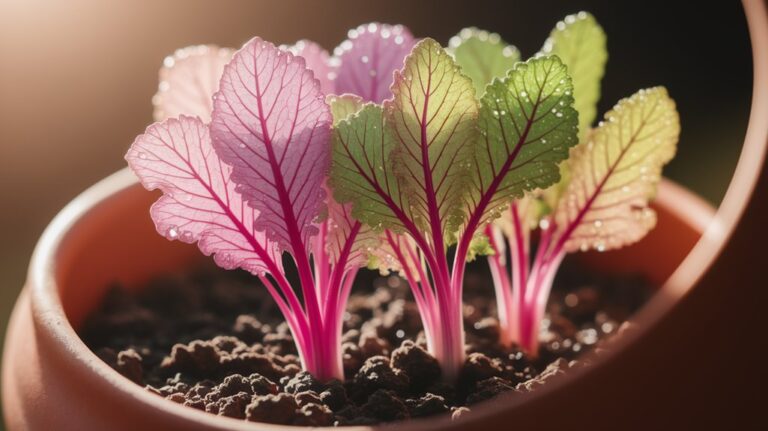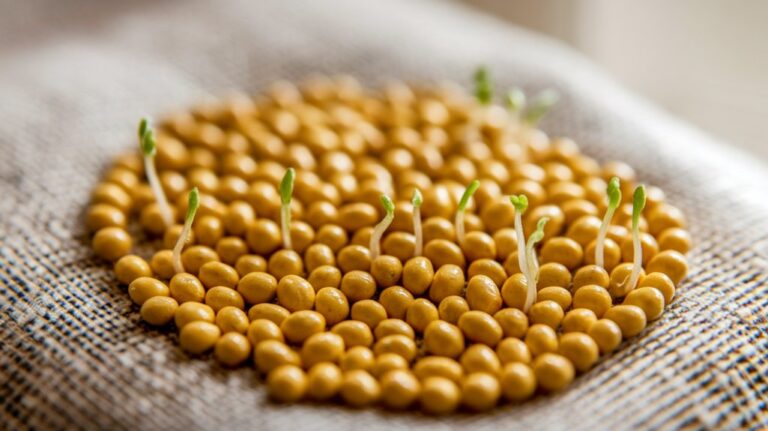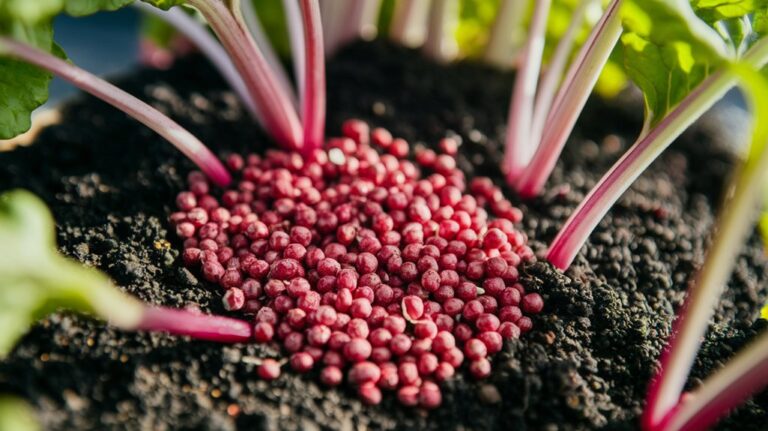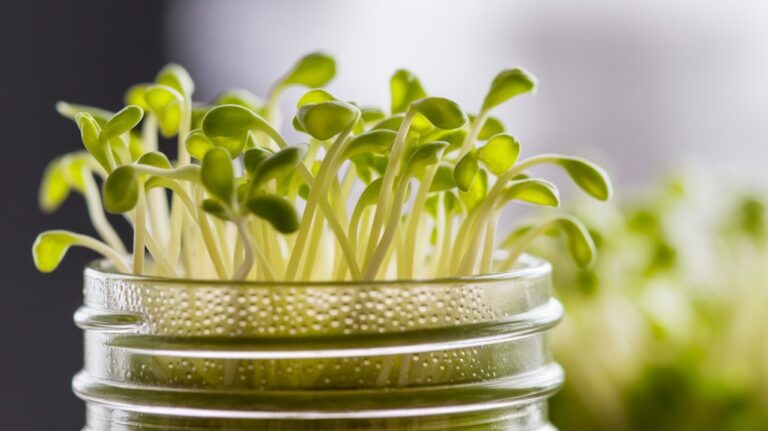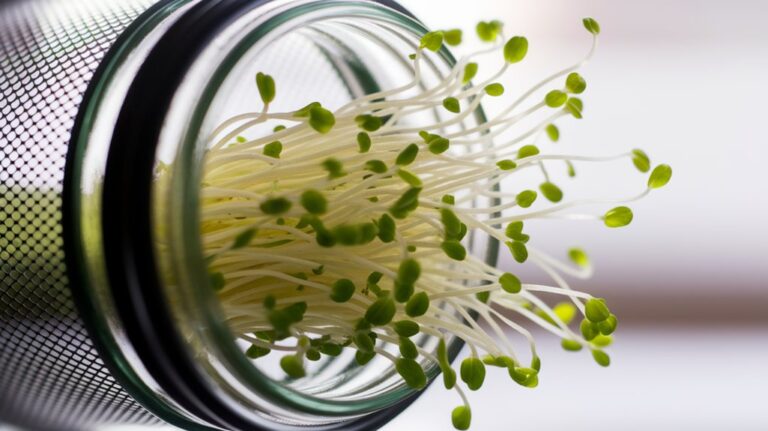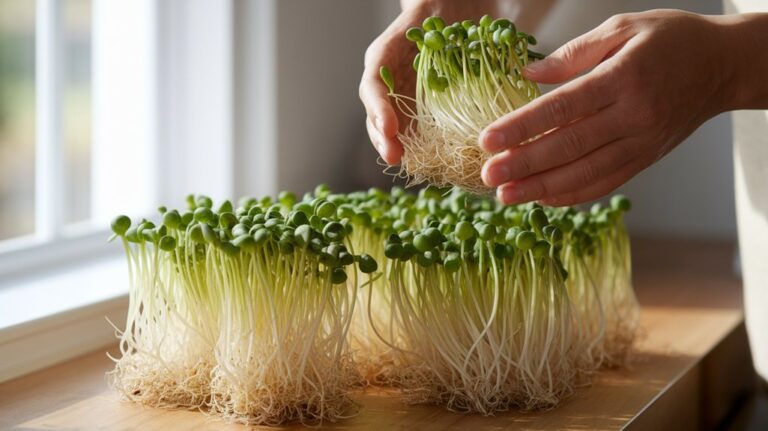Sprouts for Every Season: A Year-Round Growing Calendar
Growing sprouts year-round is a rewarding and nutritious endeavor. In spring, I love cultivating alfalfa and broccoli sprouts for their mild flavors. Summer is perfect for heat-tolerant mung beans and radishes. As fall approaches, I transition to hardy crops like broccoli and alfalfa. During winter, I grow my favorite sprouts indoors, ensuring fresh greens throughout the chilly months. I’ve found this process easy and beneficial, and I can’t wait to share more about sprouting success!
Key Takeaways
- Spring is ideal for growing alfalfa, radish, broccoli, pea shoots, and sunflower sprouts, thriving in temperatures of 65-75°F.
- Summer favors heat-tolerant sprouts like mung beans and sunflower sprouts, benefiting from warm conditions and ample sunlight.
- In winter, grow alfalfa, broccoli, and radish sprouts indoors, ensuring temperatures remain consistent at 65-75°F.
- Optimal light exposure for sprouts should be 12-16 hours daily, using indirect sunlight or grow lights as needed.
- Maintain consistent moisture and airflow to prevent mold while ensuring proper drainage to promote healthy sprout growth.
The Benefits of Growing Sprouts
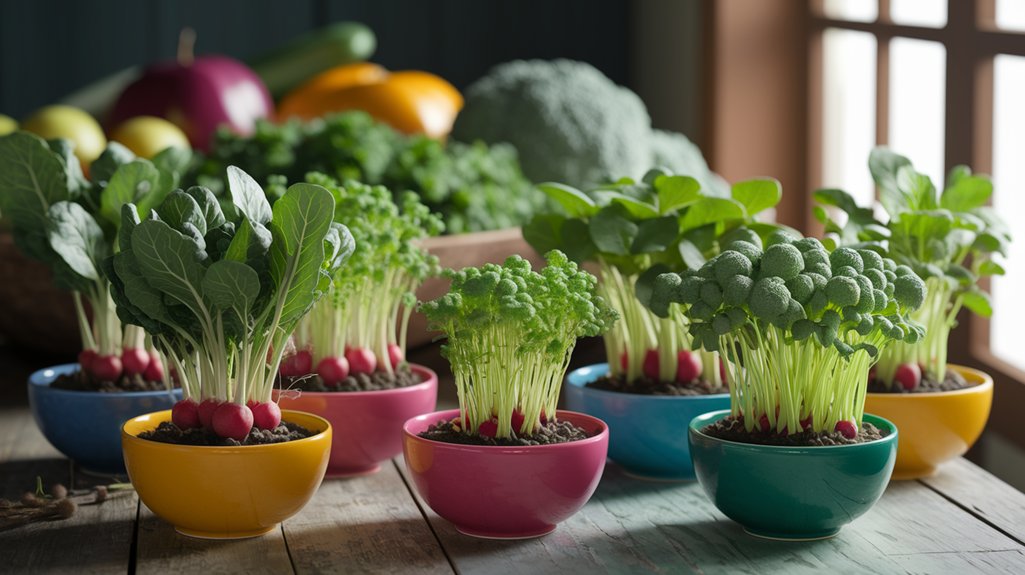
When I first started growing sprouts, I quickly realized they offer a remarkable array of health benefits that can enhance our diets. Sprouts are nutrient-dense, packed with vitamins, minerals, and antioxidants that support overall health.
For instance, studies show that sprouted seeds can contain up to 30 times more nutrients than their mature counterparts. They’re also rich in enzymes, aiding digestion and absorption of nutrients, which is vital for overall wellness.
Plus, growing sprouts at home is incredibly easy and cost-effective. You don’t need much space or special equipment. Just a jar, some seeds, and water can transform your meals.
Incorporating these tiny powerhouses into my diet has improved my energy levels, boosted my immune system, and added delightful crunch to my meals.
Spring Sprouts: Ideal Varieties for the Season
As spring approaches, I’m excited to explore the best varieties of sprouts to grow during this vibrant season.
Varieties like alfalfa, radish, and broccoli thrive in the cooler temperatures and longer daylight hours of spring, making them ideal choices.
Understanding their optimal growing conditions can really enhance your success, so let’s break that down.
Best Varieties to Grow
While spring brings a burst of life to our gardens, choosing the right varieties of sprouts can significantly enhance your harvest. I’ve found that certain sprouts thrive in the spring, offering both flavor and nutrition. Here are my top picks:
| Sprout Variety | Flavor Profile | Harvest Time |
|---|---|---|
| Broccoli Sprouts | Mild, slightly nutty | 5-7 days |
| Radish Sprouts | Spicy, peppery | 5-10 days |
| Pea Shoots | Sweet, fresh | 14-21 days |
| Sunflower Sprouts | Nutty, crunchy | 7-10 days |
These varieties not only grow quickly but also add vibrant flavors to salads and sandwiches. I can’t wait to see my garden flourish with these delicious options!
Optimal Growing Conditions
Choosing the right varieties of sprouts is just the beginning; understanding their optimal growing conditions is key to a successful harvest.
In spring, I focus on creating the perfect environment for my sprouts, ensuring they thrive. Here are four essential conditions to consider:
- Temperature: Keep the growing area between 65-75°F (18-24°C) for ideal germination.
- Light: Provide indirect sunlight or use fluorescent lights for 12-16 hours daily to promote healthy growth.
- Moisture: Maintain consistent moisture levels, but avoid waterlogging; sprout seeds should be damp, not soaking.
- Air Circulation: Ensure good airflow to prevent mold and mildew, which can jeopardize your crop.
Summer Sprouts: Thriving in the Heat
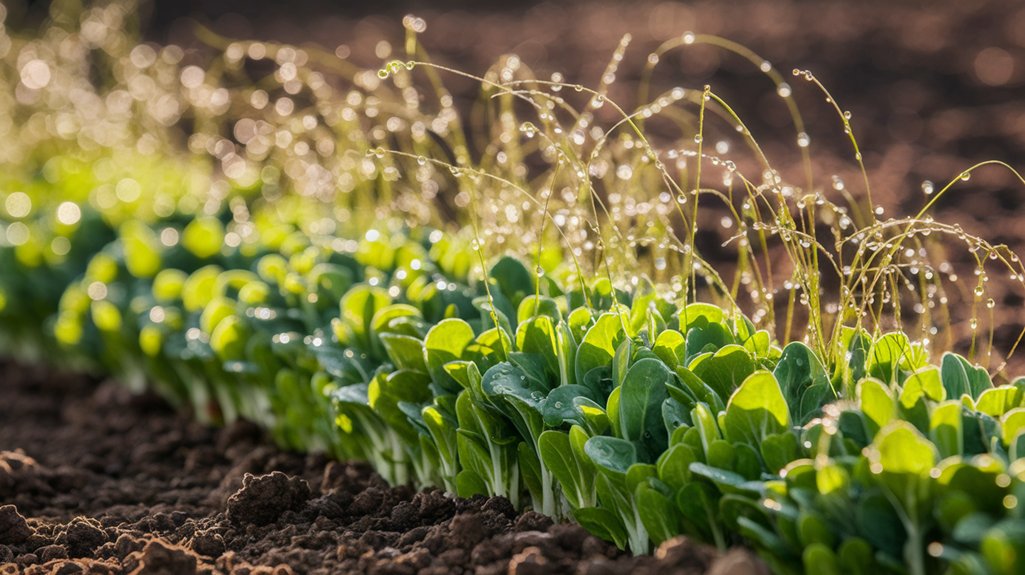
As summer approaches, I find it essential to focus on heat-tolerant sprout varieties that can thrive in higher temperatures.
These varieties, such as mung beans and sunflower sprouts, require specific growing conditions to maximize their potential.
In this discussion, I’ll share practical tips to help you cultivate robust sprouts even in the sweltering heat.
Heat-Tolerant Sprout Varieties
Summer can be a challenging time for growing sprouts, but fear not—heat-tolerant varieties thrive in these conditions.
I’ve discovered a few that not only withstand the heat but also deliver great flavor and nutrition. Here are my top four heat-tolerant sprout varieties:
- Alfalfa: These sprouts provide a crunchy texture and are rich in vitamins A, C, and K.
- Mung Bean: Known for their sweet flavor, they’re packed with protein and can sprout quickly.
- Radish: With a peppery taste, radish sprouts grow well in warm conditions and add a zesty kick to dishes.
- Broccoli: These sprouts are nutrient-dense and known for their cancer-fighting properties, thriving even in the summer heat.
Give these varieties a try, and you won’t be disappointed!
Optimal Growing Conditions
Growing heat-tolerant sprouts is just the beginning; understanding their optimal growing conditions is key to success.
For summer sprouts, I prioritize a temperature range between 70°F and 85°F, ensuring they thrive without bolting. I use well-draining soil, rich in organic matter, to maintain moisture while preventing root rot.
Adequate sunlight is crucial, so I place them in a location that receives at least six hours of indirect light daily. I also monitor humidity levels; a slightly elevated humidity can enhance sprout growth.
Regular watering is essential, but I avoid over-saturating the soil. By maintaining these specific conditions, I’ve consistently enjoyed a bountiful harvest of vibrant, nutritious summer sprouts.
Fall Sprouts: Harvesting the Season’s Bounty
While the days begin to shorten and temperatures drop, I find that fall is an ideal time to reap the rewards of my efforts in the garden.
This season, I focus on harvesting a variety of sprouts that thrive in cooler temperatures. Here are my top four picks:
- Broccoli Sprouts: Rich in nutrients and perfect for salads or sandwiches.
- Radish Sprouts: They add a spicy crunch and grow quickly in fall.
- Mustard Sprouts: With their peppery flavor, they’re excellent for garnishing dishes.
- Pea Shoots: Sweet and tender, these are delightful in stir-fries or fresh salads.
Winter Sprouts: Growing Indoors for Freshness
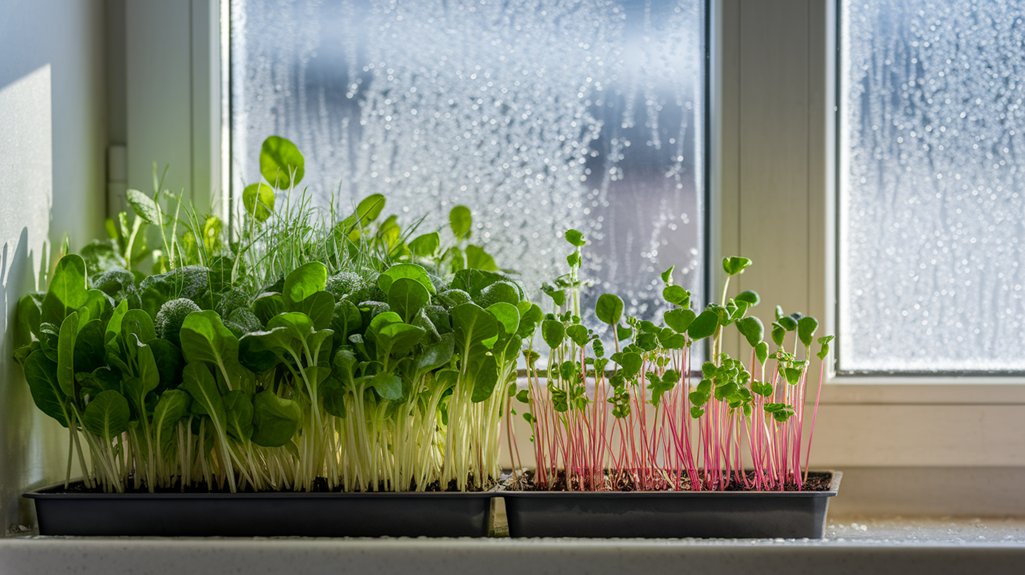
As winter settles in, I find that growing sprouts indoors can be a rewarding way to maintain freshness in my meals.
Creating the ideal indoor conditions—like proper light, temperature, and humidity—ensures that my sprouts thrive throughout the colder months.
Some of the best winter sprouts I’ve had success with include alfalfa, broccoli, and radish, each offering unique flavors and nutritional benefits.
Ideal Indoor Conditions
To ensure optimal growth for your winter sprouts indoors, I recommend creating a controlled environment that mimics their ideal conditions.
Here are four key factors to consider:
- Light: Place your sprouts near a south-facing window or use grow lights for 12-16 hours a day to encourage healthy growth.
- Temperature: Maintain a consistent temperature between 65-75°F (18-24°C) to promote germination and growth.
- Humidity: Keep humidity levels around 40-60%. You can achieve this by misting your sprouts daily or using a humidity dome.
- Air Circulation: Ensure good airflow by placing a small fan nearby. This helps prevent mold and keeps your sprouts thriving.
Best Winter Sprouts
When I think about the best winter sprouts to grow indoors, several varieties stand out for their robust flavors and nutritional benefits.
Broccoli sprouts are a top choice; they’re rich in sulforaphane, which supports immune health. I also love growing radish sprouts—they’re peppery and add a kick to salads.
Alfalfa sprouts are another excellent option, packed with vitamins A, C, and K, making them perfect for sandwiches. For something unique, try mustard sprouts; they bring a delightful zest.
To grow these indoors, I use a seed tray with good drainage and a light source, ensuring they get enough moisture and warmth.
With a little care, I’ve enjoyed fresh, nutritious sprouts all winter long.
Essential Tools for Sprout Cultivation
While I often find myself immersed in the world of sprout cultivation, having the right tools makes all the difference in ensuring success.
Here are four essential tools I recommend for any aspiring sprout grower:
- Sprouting Jar: A glass jar with a mesh lid allows for proper airflow and drainage.
- Sprout Tray: Ideal for larger batches, these trays provide ample space for seeds to grow and spread.
- Watering Can: A fine-mist watering can helps evenly moisten sprouts without over-saturating.
- Thermometer: Keeping track of temperature ensures that your sprouts thrive in optimal conditions.
With these tools in hand, I’ve found sprout cultivation not only easier but also more rewarding.
Happy sprouting!
Step-by-Step Guide to Sprouting Seeds
Getting started with sprouting seeds is a straightforward process that can yield delicious and nutritious results.
First, I select high-quality seeds like alfalfa, broccoli, or radish. I rinse about two tablespoons of seeds in cold water, ensuring they’re clean.
Then, I place them in a jar, cover it with a breathable cloth, and secure it with a rubber band. Next, I soak the seeds in water for around 4-8 hours.
After soaking, I drain the water and rinse the seeds again. I store the jar in a dark, warm spot, rinsing the seeds twice daily.
Within 3-7 days, I see tiny sprouts, ready to enjoy in salads or sandwiches. It’s that simple!
Caring for Your Sprouts: Watering and Light Needs
To ensure your sprouts thrive, it’s crucial to pay attention to their watering and light needs. I’ve found that a few key practices make all the difference:
- Watering Frequency: Keep the soil consistently moist, but not soggy. I usually water my sprouts every day or every other day, depending on humidity.
- Drainage: Ensure your containers have proper drainage. It prevents root rot and promotes healthy growth.
- Light Exposure: Place your sprouts in a bright location with indirect sunlight. Too much direct light can harm delicate plants.
- Light Duration: Aim for about 12-16 hours of light daily. I often use a grow light if natural light isn’t sufficient.
Following these tips will help your sprouts flourish beautifully!
Nutritional Benefits of Various Sprouts
After ensuring your sprouts are well-cared for, it’s time to appreciate their impressive nutritional benefits. Sprouts are packed with vitamins, minerals, and antioxidants, making them a powerhouse for health. For instance, alfalfa sprouts are rich in vitamin K, while broccoli sprouts contain sulforaphane, known for its cancer-fighting properties.
Here’s a quick comparison of some popular sprouts:
| Sprout | Key Nutrients | Health Benefits |
|---|---|---|
| Alfalfa | Vitamin K, C, and fiber | Supports bone health |
| Broccoli | Vitamins A, C, and sulforaphane | Potential cancer protection |
| Mung Bean | Protein, vitamins B and C | Aids digestion and boosts energy |
| Radish | Vitamin C and antioxidants | Supports immune function |
Including these in your diet can significantly enhance your nutritional intake!
Creative Ways to Incorporate Sprouts Into Your Meals
While many might think of sprouts as mere garnishes, I’ve found they can truly elevate a variety of dishes when incorporated thoughtfully.
Here are some creative ways I love to use sprouts:
- Salads: Mixing sprouts like alfalfa or broccoli into my salads adds crunch and boosts nutrition.
- Sandwiches: I layer them in wraps or sandwiches for a fresh, zesty flavor, perfect with avocado or hummus.
- Stir-Fries: Tossing bean sprouts into my stir-fries adds texture and absorbs flavors beautifully.
- Soups: I sprinkle sprouts on top of soups just before serving, giving a delightful contrast to warm broth.
Incorporating sprouts not only enhances taste but also packs a nutritional punch, making my meals more wholesome.
Frequently Asked Questions
How Long Do Sprouts Typically Take to Grow?
I’ve found that sprouts typically take about 5 to 14 days to grow, depending on the type.
For instance, alfalfa sprouts usually sprout within 5 to 7 days, while broccoli sprouts can take up to 14 days.
It’s crucial to keep them moist and in a well-ventilated space. Each day, I rinse them to prevent mold, ensuring they develop properly.
With a bit of care, you’ll have fresh sprouts ready to eat in no time!
Can I Grow Sprouts Without Soil?
Absolutely, you can grow sprouts without soil! I’ve done it using just water and a jar.
I soak the seeds overnight, then drain and rinse them twice daily. Within a few days, I see tiny sprouts emerging. It’s fascinating to watch!
The key is keeping the seeds moist but not submerged. I find it rewarding and a great way to enjoy fresh greens right from my kitchen.
Give it a try—you won’t regret it!
What Common Pests Affect Sprout Growth?
When I grow sprouts, I often encounter common pests that can hinder their growth.
Aphids, for instance, are tiny insects that suck the sap from the sprouts, stunting their development. I’ve also dealt with fungus gnats, which can infest the soil or growing medium.
To combat these pests, I use neem oil or insecticidal soap, ensuring I maintain a clean growing environment. Regularly inspecting my sprouts helps me catch any infestations early.
Are There Any Specific Diseases Related to Sprouts?
When it comes to growing sprouts, I’m always mindful of specific diseases that can affect them.
I’ve encountered issues like damping-off, a fungal disease that can cause seedlings to wilt and die. Root rot is another concern, often due to overwatering.
To combat these, I ensure proper drainage and avoid overcrowding. Regularly inspecting my sprouts helps me catch any signs of disease early, keeping my crop healthy and vibrant.
How Can I Store Harvested Sprouts for Freshness?
To keep my harvested sprouts fresh, I wash them gently in cold water, then drain them thoroughly.
I store them in a clean, dry container lined with a paper towel to absorb excess moisture.
I find that placing the container in the refrigerator prolongs their freshness, ideally consuming them within a week.
Checking for any signs of spoilage regularly ensures I enjoy the best flavor and nutrition from my sprouts.
Conclusion
Incorporating sprouts into your diet year-round can truly elevate your meals and boost your health. By understanding the unique varieties that thrive in each season, you can enjoy fresh, nutrient-packed sprouts regardless of the weather. With a bit of care and the right techniques, sprouting can be a simple yet rewarding hobby. So, why not give it a try? Start sprouting today, and relish the vibrant flavors and health benefits these tiny powerhouses bring to your table!


